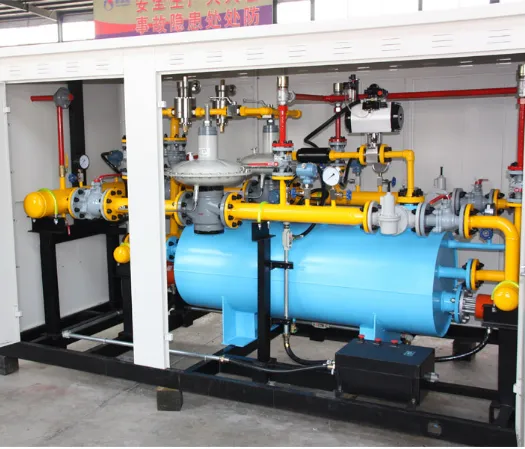
Feb . 26, 2025 15:04
Back to list
The Role of Decompression Equipment in CNG Systems
Compressed Natural Gas (CNG) is rapidly becoming one of the most reliable and eco-friendly alternatives to traditional fuels, with its use expanding across various industries, especially in transportation and energy sectors. To ensure its safe and efficient use, a key component of the infrastructure is the decompression equipment. This system is essential for regulating and reducing the high pressure of CNG, making it suitable for utilization. In this article, we explore the importance of CNG, decompression equipment, and decompression skids in modern natural gas systems.

Understanding CNG: A Cleaner and Safer Energy Source
CNG is natural gas that has been compressed to less than 1% of its volume at standard atmospheric pressure, making it a highly efficient fuel for vehicles and industrial applications. The primary component of CNG is methane (CH4), and when used as a fuel, it produces fewer pollutants compared to gasoline or diesel. This makes CNG a much cleaner, safer, and more sustainable energy source for many industries, including transportation, heating, and power generation.
To safely store and transport CNG, it must be compressed to high pressures, often ranging from 2,900 to 3,600 psi. The safe and efficient use of this high-pressure gas requires specialized systems to control and reduce its pressure, especially when it reaches end-use facilities or vehicles. Here is where decompression equipment plays a crucial role.
The Essential Role of Decompression Equipment in CNG Systems
Decompression equipment is designed to reduce the pressure of CNG from high levels to safe, usable levels. This is an essential component in any CNG distribution or refueling station. When CNG is transferred from storage tanks or pipelines, the gas must pass through decompression equipment to ensure that it is delivered at the appropriate pressure for use in vehicles or industrial applications.
The function of decompression equipment is not just to reduce pressure but also to ensure the gas flow is stable and controlled. This equipment is engineered to handle the high-pressure demands of CNG systems, ensuring there are no risks of overpressure, which could lead to system failures or accidents. With the correct pressure reduction, CNG can be safely and efficiently used, whether for fueling vehicles or powering industrial machinery.
Decompression Skid: Compact and Efficient Pressure Control
A decompression skid is a pre-assembled unit that contains all the necessary components to regulate and control the pressure of CNG. It typically includes pressure regulators, valves, filters, and safety devices, all mounted on a compact skid structure. Decompression skids are designed to be easy to install, transport, and maintain, making them a popular choice for CNG stations and industrial applications.
The decompression skid is particularly useful in situations where space is limited or when multiple pressure regulation points are required. Since CNG systems often involve complex installations, decompression skids streamline the process by consolidating all essential components into a single, ready-to-deploy unit. Whether used for fueling stations or in industries that rely on CNG for power generation, the decompression skid ensures that the pressure of CNG is precisely controlled, reducing risks and optimizing performance.
Safety and Reliability: Why Decompression Equipment Matters
The safety and reliability of decompression equipment cannot be overstated. Because CNG is stored at such high pressures, any failure in the pressure regulation process can have catastrophic consequences. Proper decompression equipment ensures that the gas is delivered at a safe pressure, preventing accidents such as over-pressurization, leaks, or explosions. The use of decompression skids also adds an extra layer of security by centralizing all pressure control mechanisms in one accessible location.
In addition to safety, the reliability of decompression equipment and decompression skids is crucial to the consistent performance of CNG systems. These components are designed for longevity and minimal maintenance, ensuring that they perform effectively under heavy use. By investing in high-quality decompression equipment and decompression skids, businesses and utilities can guarantee uninterrupted and safe CNG supply to their operations.
CNG Industry Growth and the Future of Decompression Technology
As the demand for CNG grows, especially in the transportation and energy sectors, the need for efficient and reliable decompression equipment will continue to increase. Innovations in decompression skids and related technologies are expected to drive further improvements in safety, efficiency, and ease of use. New advancements may focus on making these systems even more compact, cost-effective, and energy-efficient while also improving their ability to handle higher pressures.
The future of CNG infrastructure will likely see more integration of automation and digital controls in decompression equipment, allowing for real-time monitoring and adjustments of pressure levels. This will not only improve the safety of CNG systems but also enhance operational efficiency. As the CNG industry continues to expand, the importance of advanced decompression equipment and decompression skids will grow, ensuring that this clean energy source can be delivered safely and efficiently.
In conclusion, CNG, decompression equipment, and decompression skids are vital elements in the infrastructure required to harness and utilize natural gas as a clean and sustainable energy source. These systems ensure that the high pressures associated with CNG are safely reduced to levels suitable for use, preventing accidents and ensuring reliable operation. With the continued growth of the CNG industry, the role of decompression equipment will only become more critical in supporting the safe and efficient distribution of this important energy source.
Latest news
-
Safety Valve Spring-Loaded Design Overpressure ProtectionNewsJul.25,2025
-
Precision Voltage Regulator AC5 Accuracy Grade PerformanceNewsJul.25,2025
-
Natural Gas Pressure Regulating Skid Industrial Pipeline ApplicationsNewsJul.25,2025
-
Natural Gas Filter Stainless Steel Mesh Element DesignNewsJul.25,2025
-
Gas Pressure Regulator Valve Direct-Acting Spring-Loaded DesignNewsJul.25,2025
-
Decompression Equipment Multi-Stage Heat Exchange System DesignNewsJul.25,2025

